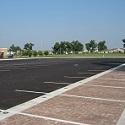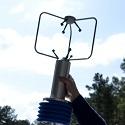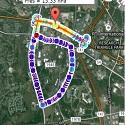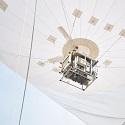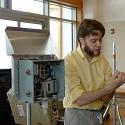EPA Science Matters Newsletter
 Living Close to Roadways: Health Concerns and Mitigation Strategies
Living Close to Roadways: Health Concerns and Mitigation Strategies
Living close to roadways can pose health risks related to pollution from traffic. EPA researchers are looking at ways to mitigate these risks, including placing vegetation barriers along roads to reduce pollution. Learn more. (Posted January 10, 2017)
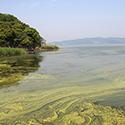 Small Systems with a Big Problem: Harmful Algal Blooms
Small Systems with a Big Problem: Harmful Algal Blooms
Harmful algal blooms are a concern for all water managers, but can be a particularly tough issue to tackle for small systems managers. Responding to these blooms in a timely and efficient manner can make all of the difference in the treatment process. Learn more. (Posted October 27, 2016)
Universities Lend a Hand with Sustainability
Through EPA's Net Zero Initiative, EPA is supporting campus-community partnerships. These partnerships help cities and communities leverage the skills and expertise of local universities to improve sustainability, the health of community members, and the environment. Read more. (Posted October 13, 2016)
Leaving the Gray Behind
Researchers with EPA’s Net Zero Program are working with the U.S. Army, U.S. Army Corps of Engineers, Kansas Unified School District 475, and others to test and demonstrate green infrastructure technology, such as permeable pavement, at Fort Riley in Kansas. Read more. (Posted June 24, 2016)
Linking Air Pollution and Heart Disease
Researchers funded by EPA’s STAR grant program at the University of Washington found a direct link between air pollution and atherosclerosis, which is a buildup of plaque in the coronary artery that can affect heart health. Read more. (Posted June 10, 2016)
Improved Methods for Estimating Chemical Exposure
EPA researchers are using new technology to improve computational exposure science, which helps create a more complete picture of how and in what amounts chemicals enter our bodies. Learn more. (Posted May 17, 2016)
Net Zero: America's Food Waste Problem
Every year in the US, approximately 133 billion pounds of food is wasted. EPA’s Net Zero Initiative is working with communities in Columbia, South Carolina, including military base Fort Jackson, to evaluate ways to reduce the amount of food waste sent to landfills. Learn more. (Posted April 22, 2016)
Net Zero: Leading the Conversation about Sustainability
Under the Net Zero Initiative, EPA is improving the environment, saving money, and helping local communities become more sustainable. Learn more. (Posted April 21, 2016)
National Coastal Condition Assessment
Coastal waters are essential to industry, tourism, recreation, and the lifecycle of various species. This is why it’s so important to monitor these waters for potentially harmful trends and to identify areas in good condition. Learn how EPA scientists assess our coastal waters. (Posted April 19, 2016)
Innovations in Air Quality Monitoring Special Issue
These are exciting times in the field of air quality measurement and monitoring. New technological advances are transforming and revolutionizing how we understand and protect air quality. Learn more in the introduction to this special issue of Science Matters. (Posted October 8, 2015)
Fenceline Monitoring
Next generation air measurement technologies are making it easier to track air pollution leaks from pipes, seals, and other areas at industrial facilities, which will help catch leaks on-site and in real time. Read more. (Posted October 8, 2015)
RETIGO: Complex Air Measurement Data Made Understandable
A new easy-to-use software program developed by EPA called RETIGO has made data analytics of environmental measurements as easy as using common spreadsheet programs. Read more. (Posted October 8, 2015)
Private, Government Collaboration Advances Air Sensor Technology
EPA and Aclima, a San Francisco-based technology company, are jointly developing new kinds of small, low-cost air pollution sensors that will provide real-time air quality information to the public. Read about this exciting collaboration. (Posted July 29, 2015)
DISCOVER-AQ: Tracking Pollution from the Skies (and Space!)
EPA and partners are working to improve sensors and satellite measurements and models that will lead to better air quality forecasts and more accurate assessments of pollution sources and fluctuations. Read more. (Posted October 8, 2015)
Monitoring Air Quality On The Go
Through EPA's Science to Achieve Results program, EPA-funded researchers at the University of California, San Diego are attempting to develop a high resolution network of optical air quality monitors that can be moved around and placed anywhere to “map” air particles, their concentrations, and related meteorological conditions. Read more. (Posted October 8, 2015)
Village Green Project
EPA is putting science into the hands of the public with the installation of Village Green air monitoring benches in cities across the country. The public can view the data collected by instruments in the benches from on-site displays and a mobile-friendly website. Read more. (Posted October 8, 2015)
Air Sensors and Wildfires
EPA scientists are launching tethered balloons called aerostats with innovative, lightweight air sensors they have developed to learn more about pollutants emitted from wildfires. This research will help us understand the health effects and emissions of wildfire smoke. Read more. (Posted October 8, 2015)
Citizen Science in Newark, New Jersey
Residents of the Ironbound community in Newark, New Jersey are getting a technological boost from EPA in their efforts to learn about sources of harmful air pollutants and improve public health. Read more. (Posted October 8, 2015)


